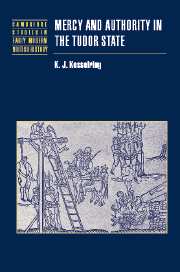Book contents
- Frontmatter
- Contents
- Acknowledgments
- Abbreviations and conventions
- 1 Introduction: mercy and the state
- 2 Changing approaches to punishment and mitigation
- 3 Changing approaches to the pardon
- 4 Patronage, petitions, and the motives for mercy
- 5 Public performances of pardon
- 6 Protest and pardons
- 7 Conclusion
- Appendix I Sources
- Appendix II Benefit of the belly
- Bibliography
- Index
- Titles in the series
5 - Public performances of pardon
Published online by Cambridge University Press: 05 July 2009
- Frontmatter
- Contents
- Acknowledgments
- Abbreviations and conventions
- 1 Introduction: mercy and the state
- 2 Changing approaches to punishment and mitigation
- 3 Changing approaches to the pardon
- 4 Patronage, petitions, and the motives for mercy
- 5 Public performances of pardon
- 6 Protest and pardons
- 7 Conclusion
- Appendix I Sources
- Appendix II Benefit of the belly
- Bibliography
- Index
- Titles in the series
Summary
Pardons made public statements about the relationships between sovereign and subject and the links between mercy and deference. Recipients generally returned to the court that had indicted or convicted them, recited their offense, and entered a plea for their pardon. They presented sureties for their future good behavior and pledged their gratitude to their merciful sovereign. The court crier then announced the pardon for all to hear and proclaimed the offenders' restoration to the protection of the law. This ceremony of remission and reintegration to the social body occurred amidst the rituals and drama of the court day. Some pardons, of course, made more spectacular statements than others. Each of the Tudor monarchs recognized the need to appear merciful and accordingly crafted public demonstrations of their princely clemency. They responded to the broad cultural demands that a legitimate ruler embody both justice and mercy, not only through the routine pardons for criminals, but also with self-consciously public performances that advertised their power over life and death. The Tudors recognized the potency of such performances for conveying varied messages to varied audiences. As Sir John Hayward noted of Elizabeth, the Tudor sovereigns knew “right well that in pompous ceremonies a secret of government doth much consist, for that the people are naturally both taken and held with exterior shows.”
These public pardons constituted part of a broader, intensely theatrical political culture. Tudor spectacles were not empty displays, superfluous to the realm of politics.
- Type
- Chapter
- Information
- Mercy and Authority in the Tudor State , pp. 136 - 162Publisher: Cambridge University PressPrint publication year: 2003



